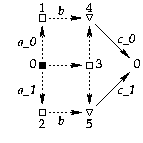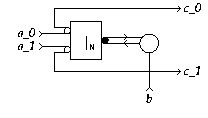EDIS:
Guide |
FAQ |
New |
Search |
Bibliography |
Index |
Feedback
Latch
Informal
A Latch has three input terminals
(a_0, a_1, and b),
and two output terminals (c_0 and c_1).
It waits for a signal on exactly one of the a_i inputs and
a signal on the b input.
In contrast to a Sequencer,
the environment must guarantee mutual exclusion of the a_i-inputs.
Having received input signals on a_i (i=0 or i=1)
and b, it produces a signal on output terminal c_i.
Rephrasing:
Both the a and the c wire pair can be viewed as
encoding one bit of data by a
One-Hot code.
When a bit is sent to the Latch via an a input,
it stores (latches) this bit until b is received.
Reception of b reproduces the bit via the corresponding c ouput.
Each pair of terminals (a_i, c_i) can be viewed as one
passive 2-phase handshake port.
A Latch synchronizes a handshake on one of its handshake ports with
the b input.
Schematic diagram
for a Latch:

[Zoom|FIG]
XDI state graph
for a Latch:

[Zoom|FIG]
Specification in XDI model.
Specification in Verdect:
define JOIN2X1( a0?, a1?, b?, c0!, c1! ) =
pref *[ (a0? || b?); c0!
| (a1? || b?); c1!
]
end
Also available through this link
Specification in DI Algebra:
L = [ a0? -> [ a1? -> _|_ # b? -> c0!; L ]
# a1? -> [ a0? -> _|_ # b? -> c1!; L ]
]
Also available through this link
XDI Report..
The roles of subscripts 0 and 1 can be interchanged
(on a and c simultaneously):
L(a_0, a_1, b; c_0, c_1) =
L(a_1, a_0, b; c_1, c_0)
It can be further generalized to
an mxn-Decision-Wait,
which awaits two choices,
one between m inputs and the other between n inputs,
and reports the combination as a choice among mn outputs.
a Latch is a
2x1-Decision-Wait.
Miscellaneous
In terms of [Ebergen89, p. 88],
the Latch is a CAL component.
The Latch is sometimes also referred to as Decision-Wait
([Lucassen94]) or 2x1-Join.
Conjecture:
A Latch cannot be implemented with only
Forks,
Joins,
Merges,
Toggles, and
I-Wires.
References
[Ebergen89, p. 88]
[Lucassen94]
Last modified at Fri Nov 20 10:11:40 1998
Encyclopaedia of Delay-Insensitive Systems
Copyright © 1995-1998
Tom Verhoeff /
Tom.Verhoeff@acm.org


